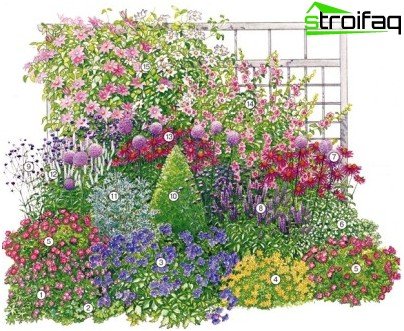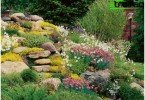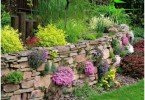Luxurious flower garden in the country
A spectacular and stylish mixborder from perennials can grow a landscape designer. But even if you are a beginner amateur gardener and want to try yourself in a new role, nothing prevents you from creating a colorful mixborder with your own hands. Arm yourself with theoretical knowledge and patience, your work will certainly be rewarded!
Content
- The first step is planning
- Useful tips and tricks
- Planting plants in height
- Choose a color scheme and style
The first step is planning
- Mixborders, photos of which you see below, can be one-sided or monitored from all sides. The choice of plant height for the flowerbed depends on the distance from the main point of view from the edge of the flower bed. In other words, the farther a flower bed is from you, the higher bushes and grasses can be planted in it..

The table “Flowering time of plants for mixborders” will help you correctly draw up a diagram for the flowerbed.
- When creating a mixborder use: dwarf trees, shrubs, herbs, ornamental cereals, potted plants.
- It is best to lay a flower garden in early spring. If you started landscaping in the fall, try to plant a flower bed before the end of September so that the root system can prepare for winter.
- Learn about the features of your chosen plant species. So, rocky grasses and shrubs will suffer on moist and fertilized soil. A plant with a creeping rhizome or with roots that grow in width will begin to oppress its neighbors, gradually take over someone else’s territory in the struggle for a place under the sun.
- As they develop, perennials and shrubs grow, consider this when planting them. With annual plants, you can fill in the empty spaces to make the composition more colorful and vibrant. When the mixborder from the shrubs “reaches maturity”, annuals are planted in the form of small intersperses to make the composition more interesting and expressive.
- Plants are planted taking into account their height, color and, most importantly, the timing of flowering. When some plants fade, others should replace them..
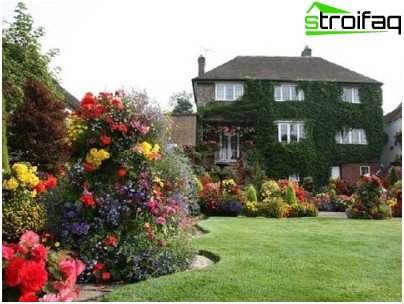
Garden landscape style: flower beds on a background of green grass.
- When planting, consider everything: the composition of the soil, lighting, protection from the wind.
- When planting together, perennials with a loose root system and spring bulbs, as well as tulips and dwarf phlox get along well with each other.
- Despite the fact that low perennials are always placed in the foreground, one or two tall plants in the “first row” will make the flower garden more expressive.
- Include juniper or thuja in the composition, the mixborder from conifers will look elegant all year round.
Useful tips and tricks
- Do not neglect the green mass. Ornamental deciduous plants (ferns, geyhera, hosts) will be a wonderful backdrop for bright garden flowers, give the flowerbed splendor. They will also help during the period when the main plants are already fading..

Plant diagram is your project plan.
- When laying the flower garden in between, you can plant tulips, imperial hazel grouse, muscari, crocuses. It is not superfluous to add plants that repel pests: cilantro, wormwood, thyme, marigolds, nasturtium.
- So that at first there are no voids on your flower garden, you can fill them with container plants. When perennials grow, the pots are simply removed from the flowerbed.
- Try not to make the borders between the heights of different plants too sharp, otherwise the composition will look unnatural.
- Want a big flower garden? Plan ahead for a narrow path that will make it easier for you to work in it..
- Computer graphics programs are very convenient, which allow landscape designers to see the “finished” mixborder at the design stage. If the client does not like the virtual mixborder, the plant layout for the mixborder is easily adjusted.
Planting plants in height
Low-growing plants: ageratum, ornamental onion, astilbe, periwinkle, galanthus, viola, cloves, heichera, crocus, daffodil, sheath, wormwood, phlox, stalk, Iberis.
Mid-sized: aster, cornflower, St. John’s wort, bell, ranunculus, mallow, stonecrop, rudbeckia.
Screen plants (they are placed in the background): digitalis, sunflower, shiritsa, cosmea, lavater, cochia, monarda, paniculate gypsophila, lily, astilbe.
It is not enough to make a mixborder of perennials with your own hands, you also need to be able to care for it. In order not to complicate your work, choose perennials with similar agrotechnical requirements.
A perennial mixborder, the photo of which is presented below, can be transported anywhere in the garden.
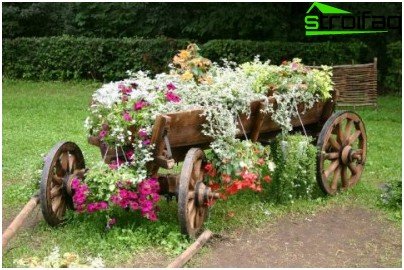
The basis of the mixborder is perennials. Choose whichever you prefer.
Choose a color scheme and style
- You can plant any type of mixed flower garden: monochrome, contrast, tint, motley – their names speak for themselves. If you do not have enough experience, choose 2 colors that are harmoniously combined with each other. To create a professional mixborder, you need to have an idea of the color scheme, be able to use the color wheel.
Mixborder scheme and flower garden (1 – Endress geranium, 2 – Soft cuff, 3 – Geranium, 4 – coreopsis, 5 – cinquefoil, 6 – yarrow, 7 – ornamental onion, 8 – fennel orchid, 9 – verbena, 10 – boxwood, 11 – wormwood, 12 – mint, 13 – echinacea, 14 – lavatera, 15 – clematis)

Top view of the flower garden (1 – Endress geranium, 2 – Soft cuff, 3 – Geranium, 4 – coreopsis, 5 – cinquefoil, 6 – yarrow, 7 – ornamental onion, 8 – fennel polyphony, 9 – verbena, 10 – boxwood, 11 – wormwood, 12 – mint, 13 – echinacea, 14 – lavatera, 15 – clematis)
- Betting on contrast? Violet and yellow, red and white – such combinations will be noticeable from a distance. Do not plant small flowering contrasting shades (e.g. alissum).
- Roses are excellent neighbors: geranium, spherical muzzle, dolphinium, bell. Plant aconite near the dolphinium. “Friends” with roses: lavender, ageratum, sage.
- One-color flowerbed looks very elegant, in it the most noticeable is the variety of shapes and sizes of buds. If you choose monochrome, your mixborder will look like an English queen – strictly, elegantly and tastefully.
- Do you want to create a corner a la “wilderness” in the garden? With the help of coniferous and woody, you can arrange natural thickets.
- The landscape style of the garden, where most often you can see a mixborder of trees and shrubs, became popular in Europe in the XVIII century. Soft, smooth transitions are an invariable feature of this style. The flower bed of wild daisies, cornflowers, poppies, bluebells, nivyanka is most suitable for a landscape style garden.


